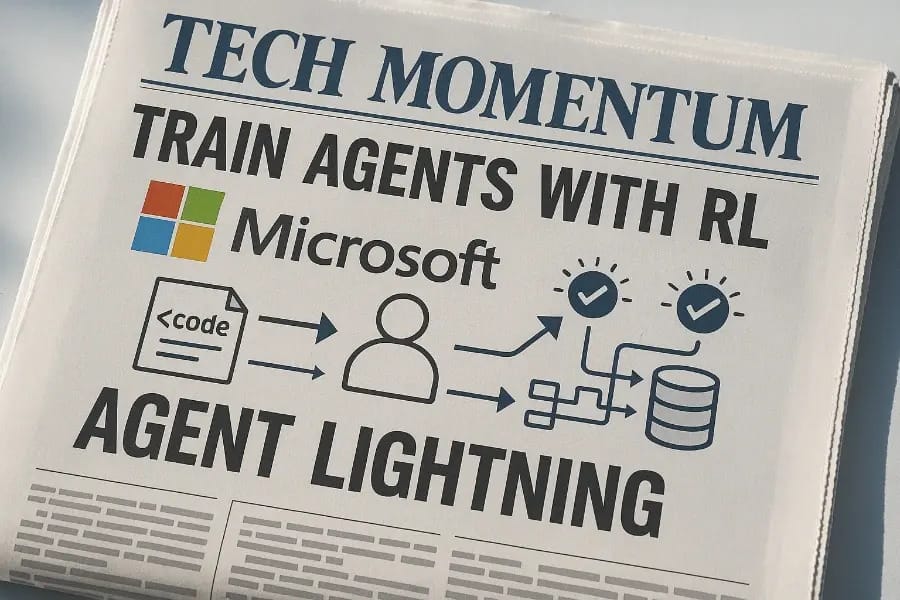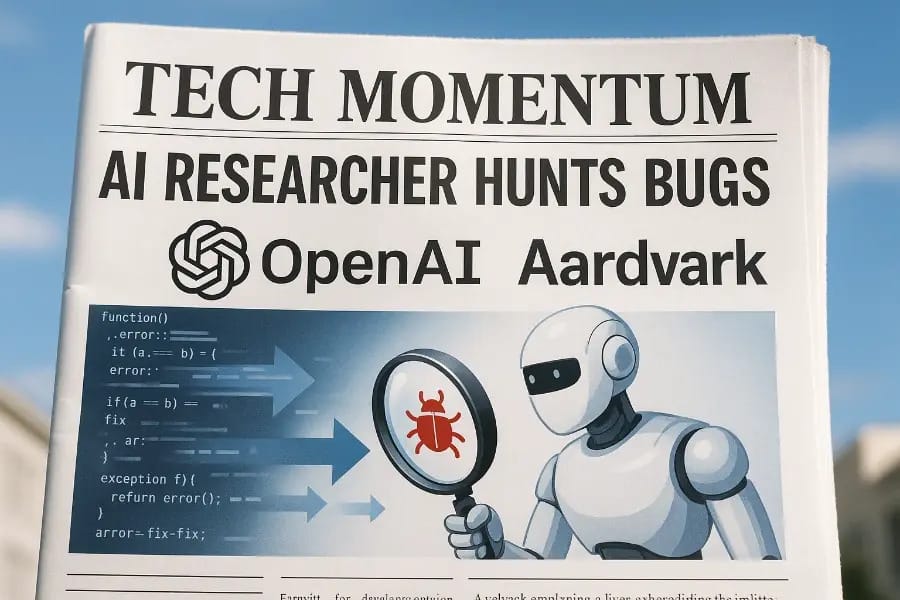- Tech Momentum
- Posts
- GeminiAI Free Access? Yes, You!
GeminiAI Free Access? Yes, You!
Run Explore how Jio, Microsoft & OpenAI reshape AI in 2025 — free Gemini access, RL agents & automated bug-hunters. Stay ahead of change. R1 Privately on Your Computer

Welcome to Tech Momentum!
If you blink, you’ll miss it — AI is moving at lightning speed. India just unlocked Gemini for millions, Microsoft made agents learn by themselves, and OpenAI launched an AI researcher that fixes code. Every move redefines how you work, code, and create.
Let’s break it all down!
Updates and Insights for Today
You Get Free 18-Month AI Access – Act Fast
You Can Train Smarter Agents Now
You Can Automate Bug-Hunting Today
The latest in AI tech
AI tools to checkout
AI News
You Get Free 18-Month AI Access – Act Fast
Quick Summary
If you’re a user of Reliance Jio Infocomm Ltd. (Jio) in India, you can now access Google Gemini AI Pro free for 18 months thanks to a new tie-up with Alphabet Inc./Google LLC. The offer includes advanced AI features, image/video tools and 2 TB of cloud storage.
Key Insights
Google and Jio will roll out the free 18-month Artificial Intelligence (AI) subscription to Jio’s ~505 million users.
The plan’s value in India is ~₹35,100 (~US$399).
Features include: access to Gemini 2.5 Pro, image & video generation models, NotebookLM for research, and 2 TB of Google cloud storage.
The rollout begins with Jio users aged 18-25 on unlimited 5G plans and then expands nationwide.
Why It’s Relevant
You stand to gain significant value if you’re a Jio customer in India, unlocking premium AI tools and storage at no extra cost. For creators, students and professionals this means access to advanced AI workflows sooner. For the broader market it signals how global tech firms are accelerating AI adoption via telecom bundling—so you could expect similar offers in other regions. The move also underscores how infrastructure investment (Google pledged ~$15 billion in India) is fuelling AI democratization.
📌 Read More: Reuters
What 100K+ Engineers Read to Stay Ahead
Your GitHub stars won't save you if you're behind on tech trends.
That's why over 100K engineers read The Code to spot what's coming next.
Get curated tech news, tools, and insights twice a week
Learn about emerging trends you can leverage at work in just 10 mins
Become the engineer who always knows what's next
You Can Train Smarter Agents Now
Quick Summary
Agent Lightning is an open-source framework from Microsoft that lets you apply reinforcement learning (RL) to any AI agent without rewriting its core code. It decouples agent execution from training and supports multi-step workflows with tools, memory, and multi-agent coordination.
Key Insights
Agent Lightning models agents as decision-processes: observation → action (model call) → reward.
It uses a “training-agent disaggregation” architecture: a client captures traces during runtime, and a server handles RL training.
It supports converting agent traces into clean RL transitions via its hierarchical algorithm called LightningRL, enabling credit assignment over long workflows.
The framework works with existing agent stacks (e.g., LangChain, AutoGen, OpenAI Agents SDK) with minimal or no code changes.
Why It’s Relevant
You gain the ability to let your AI agents learn from their own interactions, not just rely on static prompts or supervised fine-tuning. This means better performance in tasks involving multi-step reasoning, tool use or long workflows. For teams deploying agentic systems, this framework reduces overhead by requiring almost no rewriting of existing logic. It also pushes the industry toward more dynamic, real-world-learning agents rather than fixed models.
📌 Read More: Marctechpost
You Can Automate Bug-Hunting Today
Quick Summary
OpenAI has launched Aardvark, a GPT-5-powered agent designed to function like a security researcher: it scans and analyzes codebases, validates exploitability, and proposes patches. The tool is currently in private beta and supports both enterprise and open-source workflows.
Key Insights
Aardvark builds a threat model of a codebase, monitors commits, and hunts vulnerabilities using LLM reasoning instead of traditional fuzzing techniques.
The system validates each finding by attempting exploit in a sandbox, thereby reducing false positives.
It integrates with patch generation via Codex and submits human-reviewable pull requests automatically.
In internal benchmarks, Aardvark identified ~92% of known and synthetic vulnerabilities in test repositories and has already discovered multiple CVEs in open-source projects.
Why It’s Relevant
You gain a new way to bolster your software’s security posture without drastically changing workflows: Aardvark works alongside existing tools and commits. Developers and security teams can catch vulnerabilities earlier, automate patch suggestions, and reduce backlog of unaddressed bugs. For the broader industry, it signals a shift toward agentic AI deeply embedded in development pipelines — meaning faster scans, fewer delays, and lower risk from unknown flaws.
📌 Read More: OpenAI
The latest in AI tech

NVIDIA, Oracle & U.S. Energy Dept. Build AI Supercomputer
NVIDIA and Oracle will power a new U.S. Department of Energy supercomputer named Solstice, using over 100,000 Blackwell GPUs and 2,200 exaflops performance. It aims to revolutionize AI-driven scientific research, energy modeling, and national security computations.
📌 Read More: NVIDIA
NVIDIA Hits $5 Trillion Valuation Amid AI Boom
NVIDIA became the world’s first $5 trillion company, driven by massive demand for AI chips. While investors celebrate, analysts warn of a possible AI bubble fueled by infrastructure hype and unsustainable growth expectations.
📌 Read More: NBC
Microsoft & OpenAI Sign New Restructuring Deal
Microsoft and OpenAI have agreed on a new deal allowing OpenAI to restructure as a public-benefit corporation valued at about $500 billion. The move lets OpenAI raise capital freely while Microsoft keeps a 27 % stake.
📌 Read More: Reuters
NVIDIA Bridges AI and Quantum Computing with NVQLink
NVIDIA unveiled NVQLink, a technology connecting quantum processors to AI supercomputers. Developed with leading quantum firms and national labs, it targets hybrid quantum-classical computing for breakthrough research.
📌 Read More: WSJ
AI Tools to check out
1. Promtist
What it does: An AI-powered prompt generator, optimizer and manager — you describe your task, and it produces a refined prompt ready for LLMs.
Use case: Ideal for developers, creators, or teams looking to standardise, version-control and reuse high-quality prompts.
👉 Try It Here: Promtist
2. PDF Translator
What it does: A web service that uses AI to translate PDF documents across 100+ languages while preserving layout and format.
Use case: Handy for professionals, researchers or global teams needing accurate translation of reports, manuals or multi-language documents.
👉 Try It Here: PDFtranslator
3. Quizify
What it does: AI quiz and funnel builder that generates interactive quizzes, assessments and marketing funnels with no technical skill required.
Use case: Useful for educators, marketers or content creators who want to engage users, collect leads and automate quiz-based workflows.
👉 Try It Here: Quizify
4. Fables
What it does: An AI-driven role-playing platform where you build worlds, design campaigns and play using an AI Game-Master and world-building tools.
Use case: Great for game designers, storytellers or hobby groups looking to create immersive interactive experiences without manual rule-management.
👉 Try It Here: Fables
Thanks for sticking with us to the end!
We'd love to hear your thoughts on today's email!
Your feedback helps us improve our content
⭐⭐⭐Superb
⭐⭐Not bad
⭐ Could've been better
Not subscribed yet? Sign up here and send it to a colleague or friend!
See you in our next edition!
Tom




